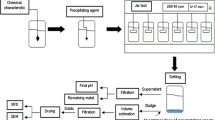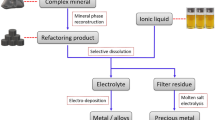Abstract
The Linz-Donawitz (LD) steelmaking process produces LD slag at a rate of about 125 kg/t. After metallic scrap recovery, the non-metallic LD slag is rejected because its physical/chemical properties are unsuitable for recycling. X-ray diffraction (XRD) studies have indicated that non-metallic LD slag contains a substantial quantity of mineral phases such as di- and tricalcium silicates. The availability of these mineral phases indicates that LD slag can be recycled by iron (Fe)-ore sintering. However, the presence of 1.2wt% phosphorus (P) in the slag renders the material unsuitable for sintering operations. Electron probe microscopic analysis (EPMA) studies indicated concentration of phosphorus in dicalcium silicate phase as calcium phosphate. The Fe-bearing phases (i.e., wustite and dicalcium ferrite) showed comparatively lower concentrations of P compared with other phases in the slag. Attempts were made to lower the P content of LD slag by adopting various beneficiation techniques. Dry high-intensity magnetic separation and jigging were performed on as-received samples with particle sizes of 6 and 3 mm. Spiral separation was conducted using samples ground to sizes of less than 1 and 0.5 mm. Among these studies, grinding to 0.5 mm followed by spiral concentration demonstrated the best results, yielding a concentrate with about 0.75wt% P and 45wt% Fe.
Similar content being viewed by others
References
I. Z. Yildirim and M. Prezzi, Chemical, mineralogical, and morphological properties of steel slag, Adv. Civ. Eng., 2011(2011), Art. No. 463638.
X. R. Wu, G. M. Yang, L. S. Li, H. H. Lü, Z. J. Wu, and X. M. Shen, Wet magnetic separation of phosphorus containing phase from modified BOF slag, Ironmaking Steelmaking, 41(2014), p. 335.
B. Das, S. Prakash, P. S. R. Reddy, and V. N. Misra, An overview of utilization of slag and sludge from steel industries, Resour. Conserv. Recycl., 50(2007), p. 40.
N. Menad, N. Kanari, and M. Save, Recovery of high grade iron compounds from LD slag by enhanced magnetic separation techniques, Int. J. Miner. Process., 126(2014), p. 1.
S. Radosavljevic, D. Milic, and M. Gavrilovski, Mineral processing of a converter slag and its use in iron ore sintering, Magn. Electr. Sep., 7(1996), No. 4, p. 201.
J. Geiseler, Use of steelworks slag in Europe, Waste Manage., 16(1996), No. 1-3, p. 59.
V. Ghai and W. H. Noseworthy, Resource recovery programs at Lake Erie Steel, Iron Steel Eng., 1998, 75(5), p. 24.
L. S. Ökvist, D. Q. Cang, Y. B. Zong, and H. Bai, The effect of BOF slag and BF flue dust on coal combustion efficiency, ISIJ Int., 44(2004), No. 9, p. 1501.
R. Panda, R. N. Karand, and C. R. Panda, Dephosphorization of LD slag by Penicillium citrinum, The Ecoscan, III(2013), Spec. Iss., p. 247.
P. Chaurand, J. Rose, V. Briois, L. Olivi, J. Hazemann, O. Proux, J. Domas, and J. Bottero, Environmental impacts of steel slag reused in road construction: a crystallographic and molecular (XANES) approach, J. Hazard. Mater., 139(2007), No. 3, p. 537.
Y. Topkaya, N. Sevinç, and A. Günaydin, Slag treatment at Kardemir integrated iron and steel works, Int. J. Miner. Process., 74(2004), No. 1-4, p. 31.
H. Nashiwa, T. Mizuno, J. Ohi, and K. Katohgi, Effective use of returned LD slagand dolomite and operation with sub lance system, Ironmaking Steelmaking, 5(1978), p. 95.
W. B. Dai, Y. Li, D. Q. Cang, Y. Y. Zhou, and Y. Fan, Effects of Sintering atmosphere on the physical and mechanical properties of modified BOF slag glass, Int. J. Miner. Metall. Mater., 21(2014), No. 5, p. 494.
K. K. Sharma, S. Swaroop, and D. S. Thakur, Recycling of LD slag through sinter route on direct charging in blast furnace at Bhilai Steel Plant, [in] Proceedings of National Seminar on Pollution Control in Steel Industries, Ranchi, 1993, p. 72.
K. Morita, M. X. Guo, N. Oka, and N. Sano, Resurrection of the iron and phosphorus resource in steel-making slag, J. Mater. Cycles Waste Manage., 4(2002), p. 93.
S. M. Jung and Y. J. Do, Reduction behaviour of BOF slag by carbon in iron, Steel Res. Int., 77(2006), p. 312.
S. H. Huang, Y. Q. Wu, X. S. Liu, Z. R. Xu, and X. H. Lv, Experimentalstudy on gasification dephosphorization of converter slag with reduction by silicon, Iron Steel, 43(2008), No. 2, p. 31.
H. Ono, A. Inagaki, T. Masui, H. Narita, T. Mitsuo, S. Nosaka, and S. Gohda, Removal of phosphorus from LD converter slag by floating of dicalcium silicate during solidification, Tetsu-to-Hagane, 66(1980), No. 9, p. 1317.
K. Yokoyama, H. Kubo, K. Mori, H. Okada, S. Takeuchi, and T. Nagasaka, Separation and recovery of phosphorus from steelmaking slags with the aid of a strong magnetic field, ISIJ Int., 47(2007), No. 10, p. 1541.
H. Kubo, K. M. Yokoyama, and T. Nagasaka, Magnetic separation of phosphorus enriched phase from multiphase dephosphorization slag, ISIJ Int., 50(2010), No. 1, p. 59.
F. J. Doucet, Effective CO2-specific sequestration capacity of steel slags and variability in their behaviour in view of industrial mineral carbonation, Miner. Eng., 23(2010), No. 3, p. 262.
A. S. Reddy, R. K. Pradhan, and S. Chandra, Utilization of basic oxygen furnace (BOF) slag in the production of a hydraulic cement binder, Int. J. Miner. Process., 79(2006), p. 98.
E. F. Wu, S. Pignolet-Brandom, and I. Iwasaki, Liberation analysis of slow cooled steel making slags: implications for phosphorus removal, [in] Proceedings of the 1st International Conference on Processing Materials for Properties, Honolulu, 1993, p. 153.
D. Y. Wang, M. F. Jiang, C. J. Liu, Y. Min, Y. Y. Cui, J. Liu, and Y. C. Zhang, Enrichment of Fe-containing phases and recovery of iron and its oxides by magnetic separation from BOF slags, Steel Res. Int., 83(2012), No. 2, p. 189.
Author information
Authors and Affiliations
Corresponding author
Rights and permissions
About this article
Cite this article
Makhija, D., Rath, R.K., Chakravarty, K. et al. Phosphorus partitioning and recovery of low-phosphorus iron-rich compounds through physical separation of Linz-Donawitz slag. Int J Miner Metall Mater 23, 751–759 (2016). https://doi.org/10.1007/s12613-016-1289-x
Received:
Revised:
Accepted:
Published:
Issue Date:
DOI: https://doi.org/10.1007/s12613-016-1289-x




